In the midst of the Rocky Mountain Region, you’ll find Utah, a state known for its stunning mountains and canyons. This landlocked state is the perfect destination for those ready to explore the world of tall, narrow slot canyons. There are over 1,000 slot canyons in Utah, and each one offers a different opportunity. Join us as we learn about the origins of slot canyons and unveil the 20 most enchanting slot canyons in Utah, along with practical trip-planning tips.
Key Points
- Slot canyons are narrow gorges with high, steep walls, often formed by the erosion of soft rocks like sandstone and basalt.
- Utah is home to the largest concentration of slot canyons in the world, with over 1,000 canyons due to its sandstone formations.
- Slot canyons are primarily shaped by erosional forces such as water and wind. Rushing water, especially from flash floods, carves out these narrow channels over millions of years.
- Wind-blown sand and abrasive particles gradually wear away the rock, creating intricate designs on the sandstone walls of the canyons.
- Slot canyons are susceptible to flash floods during rainstorms. A mere 1/4 inch of rain can transform them into treacherous watercourses.
- Before exploring slot canyons, it’s crucial to check the weather forecast and be vigilant for dark clouds, particularly in July and August, known for rainstorms.
- For safety, beginners should choose slot canyons with exits every 15 minutes along the route, allowing a quick escape in case of emergencies.
- Slot canyon adventures can range from simple hikes to technical canyoneering involving rappelling and water pools. Choose your adventure based on experience and preferences.
- For canyoneering, especially if you’re new to it, consider hiring experienced local guides who can ensure a safe and enjoyable experience.
- Canyoneering involves various techniques like bridging, rappelling, stemming, potholing, chimneying, handlining, anchoring, and belaying, depending on the terrain and obstacles encountered.
1. Antelope Canyon
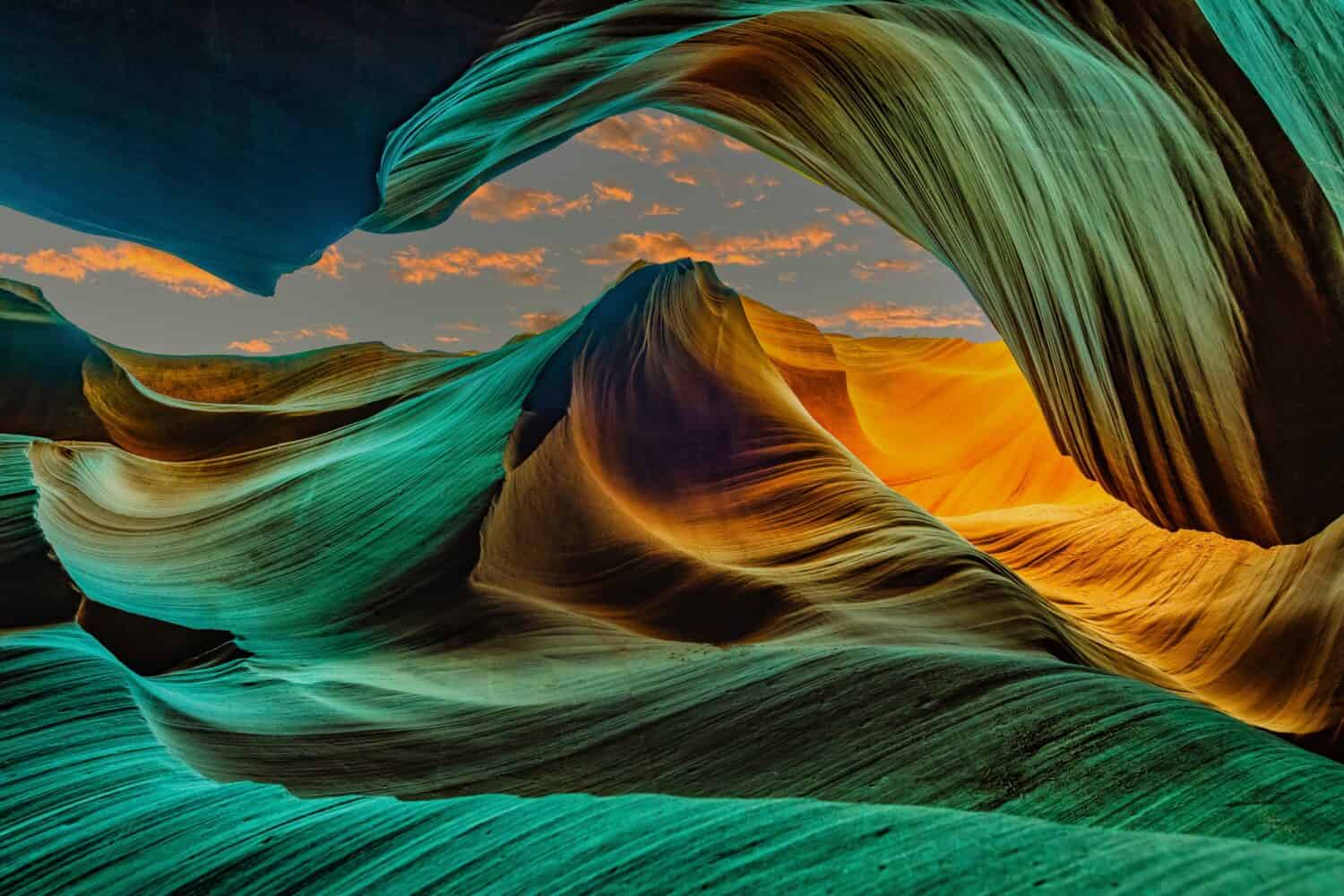
Slot canyons are carved from sandstone, resulting in smooth, intricate walls.
©finepic/Shutterstock.com
A must-visit on any trip to Arizona or Utah, Antelope Canyon is right by the Utah-Arizona border. It’s the most photographed slot canyon in the world. The canyon is carved from Navajo sandstone, resulting in smooth, intricate walls. Shaped by wind and water, it forms a tight 120-foot-deep slot canyon. Ideal times to visit are spring to fall, but summers and weekends can be very busy. Due to its popularity, securing tour slots can be challenging, so plan and book well in advance.
2. Moonshine Wash
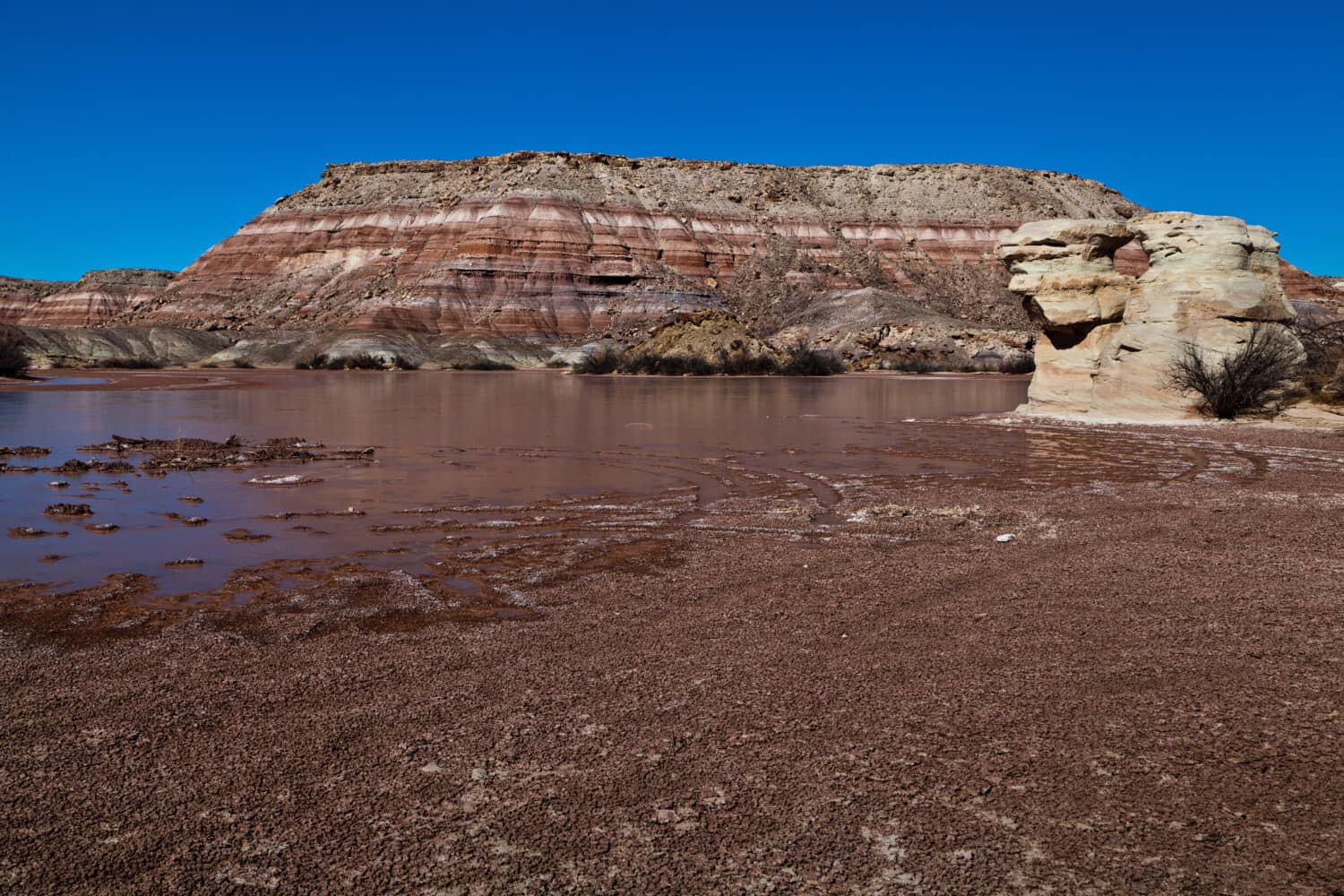
The scenic hike up to the slot canyon is a big part of the outdoor experience.
©Bogdan Denysyuk/Shutterstock.com
Moonshine Wash is a nontechnical slot canyon that provides a challenging adventure, with a little bit of everything. Situated right by the Green River, some spots of the trail even involve wading. It can take about 5 hours or more to completely explore the canyon, but there are shorter routes available. Bring your map reading skills, a GPS, and of course a camera. Highlights of the hike include breathtaking landscape views of the San Rafael Swell from the rim walk.
3. Red Hollow Slot Canyon

Certain slot canyons, like Red Hollow, are easy for beginners and families.
©Guy William/Shutterstock.com
Looking for an easier choice? Then Red Hollow Slot Canyon, right by Orderville, is the perfect spot. This 1.2-mile round-trip hike has a relatively flat bottom. The road to the trailhead is usually in good condition, making it accessible by any vehicle. So don’t worry about bringing a 4WD or high-clearance ride.
The well-marked trail takes you through picturesque desert landscapes and can be completed in just a couple of hours, even with children. Once you’ve finished exploring Red Hollow, retrace your steps down the wash to return. The best time to visit is spring and fall for mild temperatures and predictable weather.
4. Leprechaun Canyon

Wear a hat and sunglasses to make your Utah explorations safe and enjoyable.
©Judith Lienert/Shutterstock.com
Here’s another great choice for beginners; the Leprechaun Canyons. This is also a prime spot if you want to have the place all to yourself. These remote canyons are located in Turkey Knob, Utah. You’ll find the routes are straightforward and easy to access. Standard technical gear works best. The shortest fork hike spans 1.8 miles and the longest canyoneering fork stretches 4 miles. Plan a visit here any time of the year, but prepare for the heat if you come during summer.
5. Buckskin Gulch

Watching the sunlight dance off the canyon walls is a breathtaking experience.
©feel4nature/Shutterstock.com
Buckskin Gulch is the longest and deepest slot canyon in the Southwest. It’s also one of the most stunning locations, especially with sunlight dancing off the sandstone walls. Anyone coming here should prepare for a challenge. The 23-mile-long canyon is rarely more than 10 feet wide, and the corridor can be hundreds of feet deep. Hikers can choose between a short hike out of Wire Pass or a more challenging multi-day trek.
6. Kanarra Falls

Certain slot canyons, like Kannara Falls, have lovely waterfalls for hikers to see.
©Jeremy Christensen/Shutterstock.com
If you’re looking for a 4-hour adventure, then Kanarra Falls Trail is the right choice. You can complete the 4-mile roundtrip hike in 3-4 hours, and it’s only moderately difficult. You’ll need a permit to hike this trail, so plan ahead. And make sure you’re coming at the right time of year. Winter hiking conditions can start as early as October and continue through March.
7. Keyhole Canyon
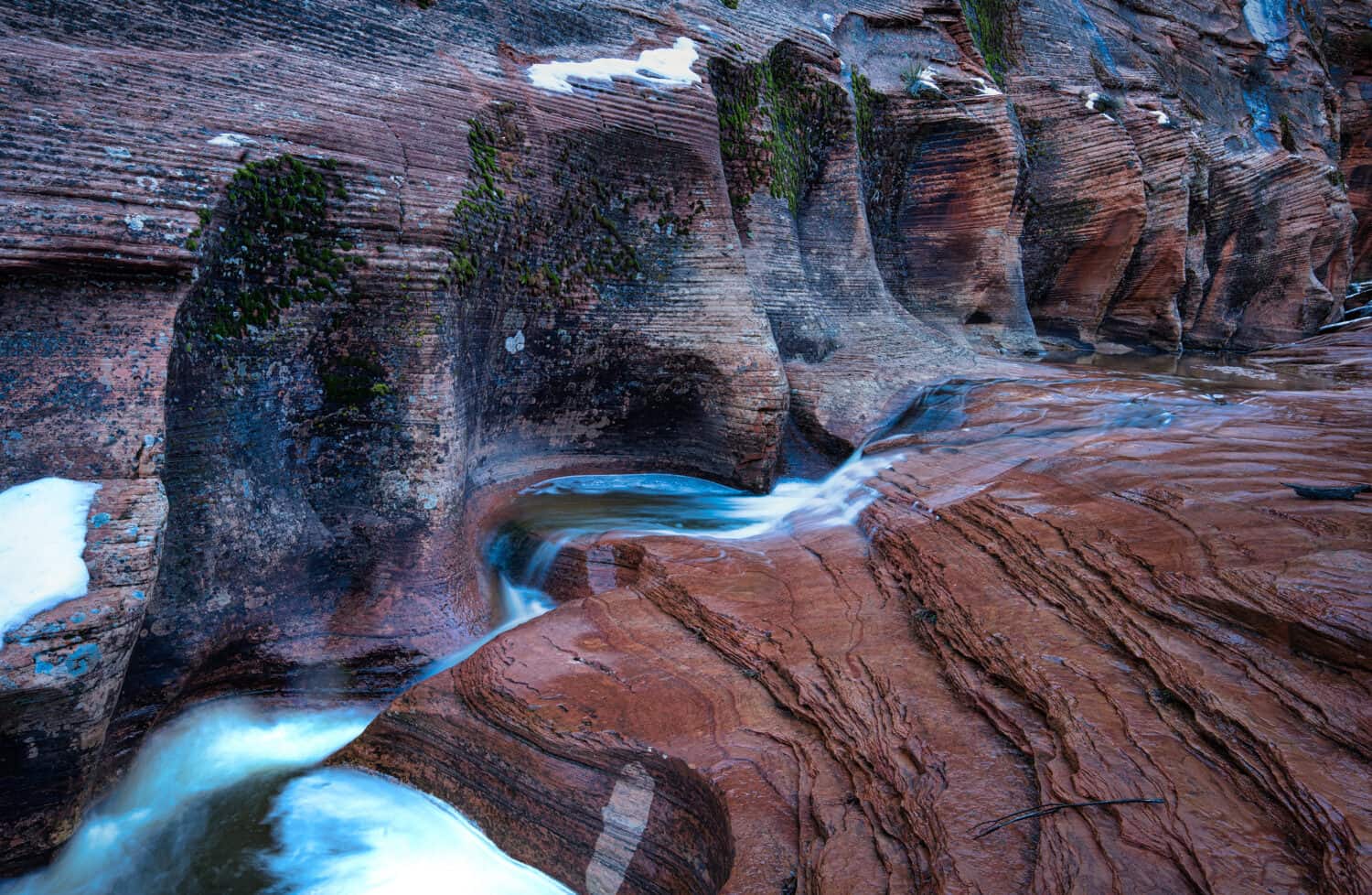
A lot of slot canyons provide canyoneers with a chance to swim!
©Remo_K/Shutterstock.com
Another fun and fast slot canyon is the Keyhole Canyon. This brief adventure takes about 2 hours and includes a few rappels and a nice swim. This spot was originally known as Starfish Canyon due to the multiple legs running in different directions on topo maps. In the late 1990s, the canyon’s name evolved into Keyhole Canyon, and it gained popularity as an easy and enjoyable outing.
8. Wire Pass Slot Canyon
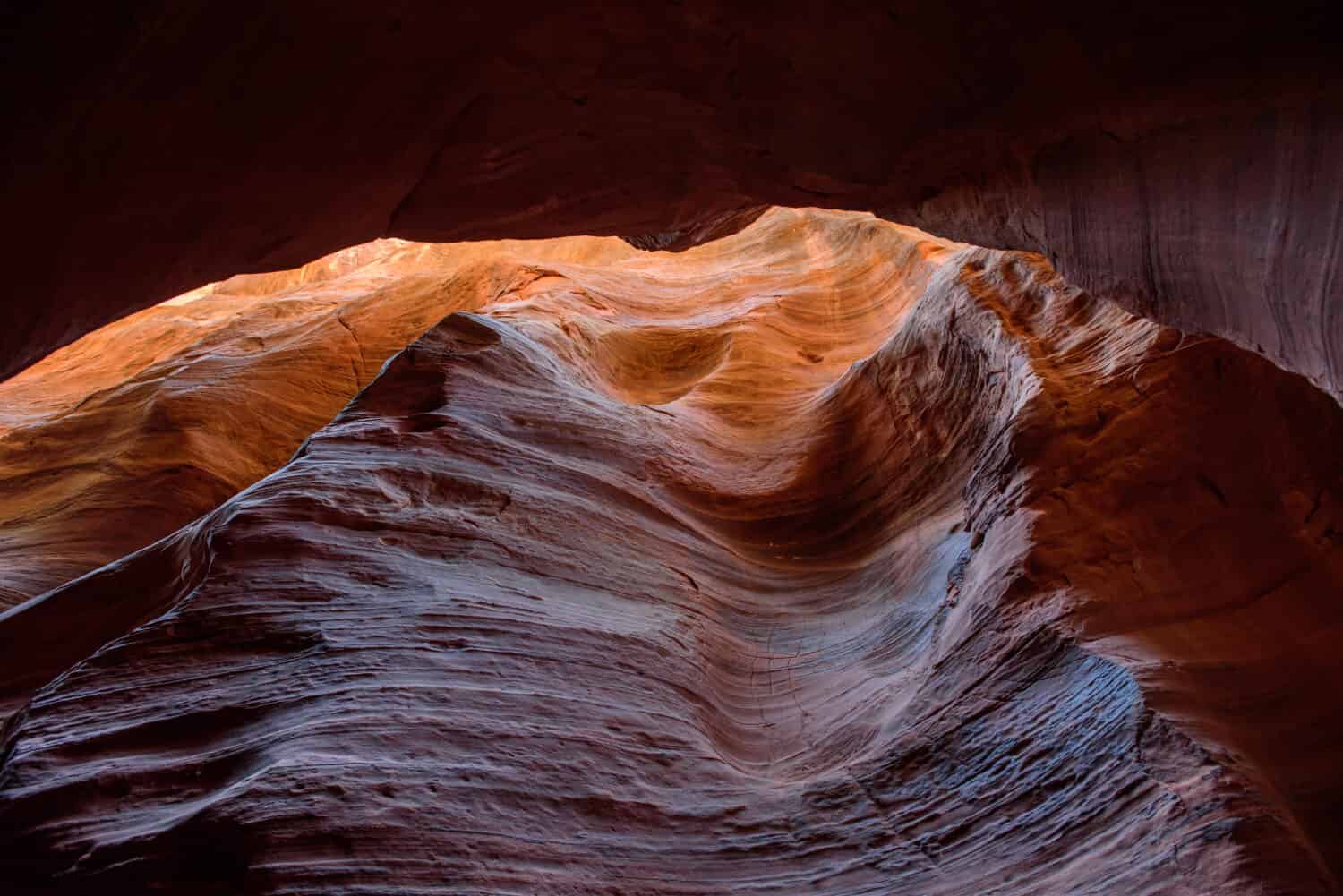
As you continue exploring the narrow canyon, you might notice the walls are becoming higher and closer.
©Jimmy W/Shutterstock.com
Wire Pass is a short drainage that connects to the longer Buckskin Gulch slot canyon. The streamway here is about 1.7 miles long, with about half a mile passing through a slot canyon. As you continue, the cliffs gradually become higher and closer together. Parts of Wire Pass are narrower than Buckskin Gulch, which makes the effect of the sunlight on the sandstone all the more dazzling.
9. Paria Canyon
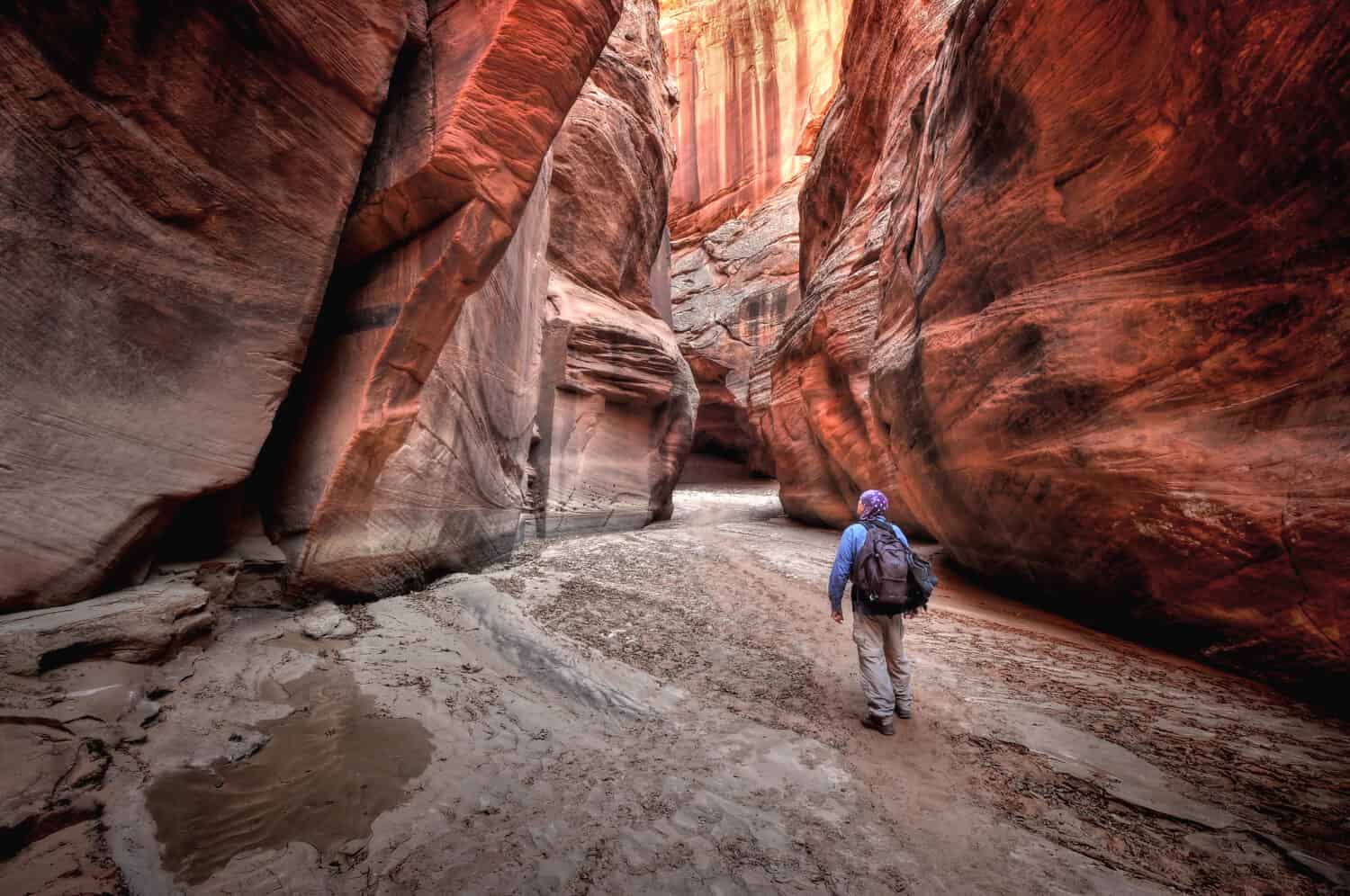
Paria Canyon is one of the locations located on a wilderness preserve.
©Sierralara/Shutterstock.com
Get ready to explore the towering walls of the Paria Canyon. This remote location is the perfect getaway spot when you want to escape day-to-day living. You might even spot deer and bighorn sheep roaming the lands. The Paria Canyon-Vermilion Cliffs Wilderness covers nearly 112,500 acres, including Kane County, Utah.
10. The Narrows

One of the most famous slot canyons in Utah is the Narrows in Zion Canyon.
©Stephen Moehle/Shutterstock.com
Appropriately named, the Narrows is the narrowest section of Zion Canyon. To explore this spot, you’ll need to hike upstream in the Virgin River, as there is no designated trail. If you want to make things easier, wait for summer to roll around. Water levels tend to be lower during the summer and early fall.
The Dry Fork Narrows offers an easy section of narrows to explore. It’s located to the left when you first reach the Dry Fork drainage. As always, check the weather conditions before heading out on your trip, and bring plenty of water.
11. The Subway

Each slot canyon has a unique formation, with some looking like underground subways.
©Pierre Leclerc/Shutterstock.com
Climbing, swimming, scrambling, and wading; the Subway slot canyon offers a bit of everything. This semi-technical slot canyon hike is in Zion National Park and takes about 7 to 9 hours to complete. Compared to the Narrows, the Subway is more difficult. Most hike the Subway from the top down, as hiking it from the bottom up is exceptionally challenging.
12. Zebra Canyon

Slot canyons have textured and sometimes patterned walls like the famously striped Zebra Canyon.
©Filip Fuxa/Shutterstock.com
Named after its striped canyon walls, Zebra Slot Canyon is located in the Grand Staircase-Escalante National Monument. The hike is about 5.2 miles roundtrip, so plan on spending 3 to 4 hours here. Don’t let the easiness of the trail leading up to the slot canyon fool you. The actual canyon can be strenuous and may require special canyoneering skills.
13. The Joint Trail
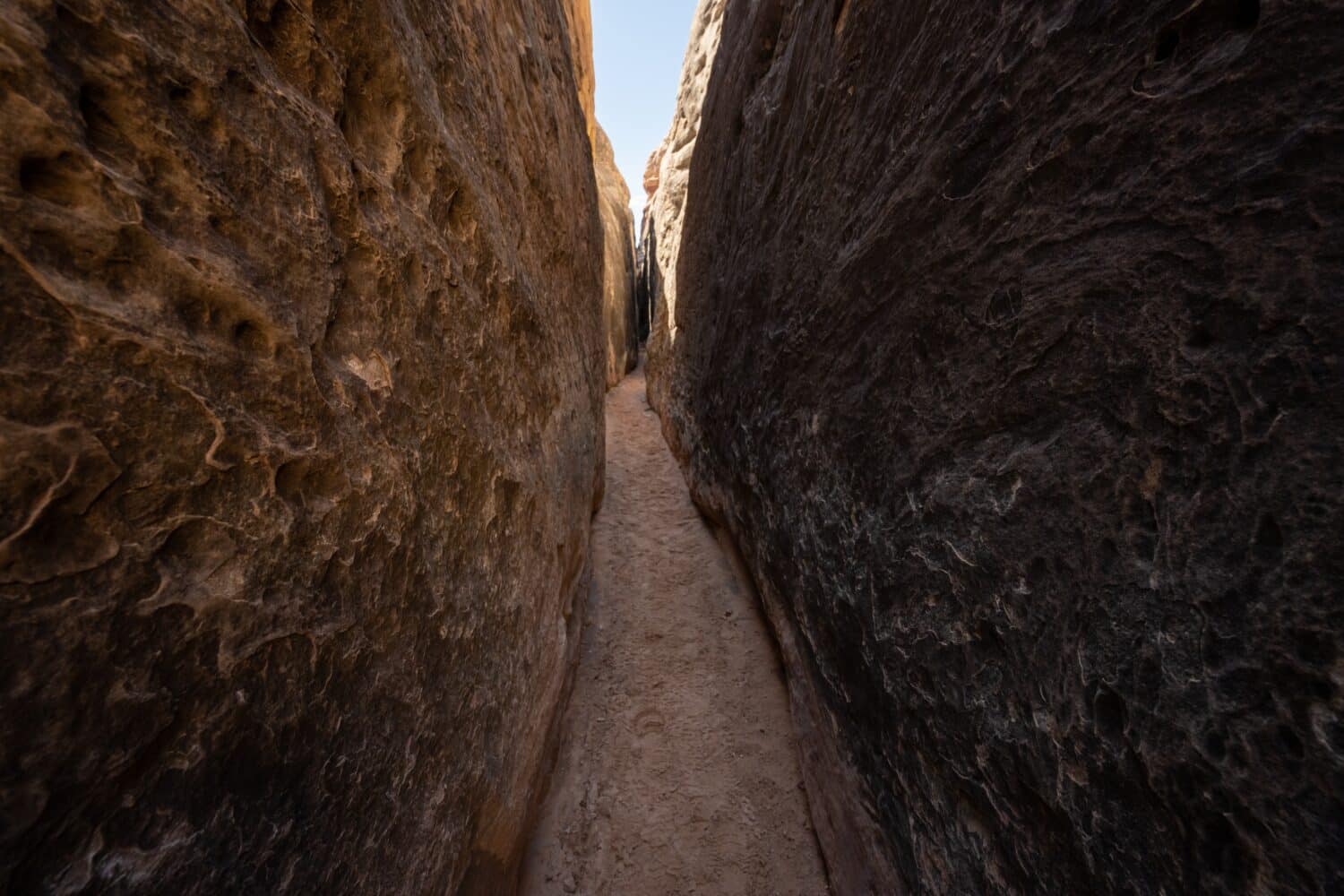
Plan plenty of time for exploring, many slot canyons will take you through gorgeous parks and other trails.
©Kelly vanDellen/Shutterstock.com
Explore a deep, narrow gap in the rock on the south side of Chesler Park. The moderately difficult Joint Trail is in the Needles District of Canyonlands National Park. It’s a section of trail located between Moab and Monticello, Utah that invites you to explore an area known as Chesler Park. This gorgeous park has lush green grass and colorful sandstone spires.
14. Little Death Hollow
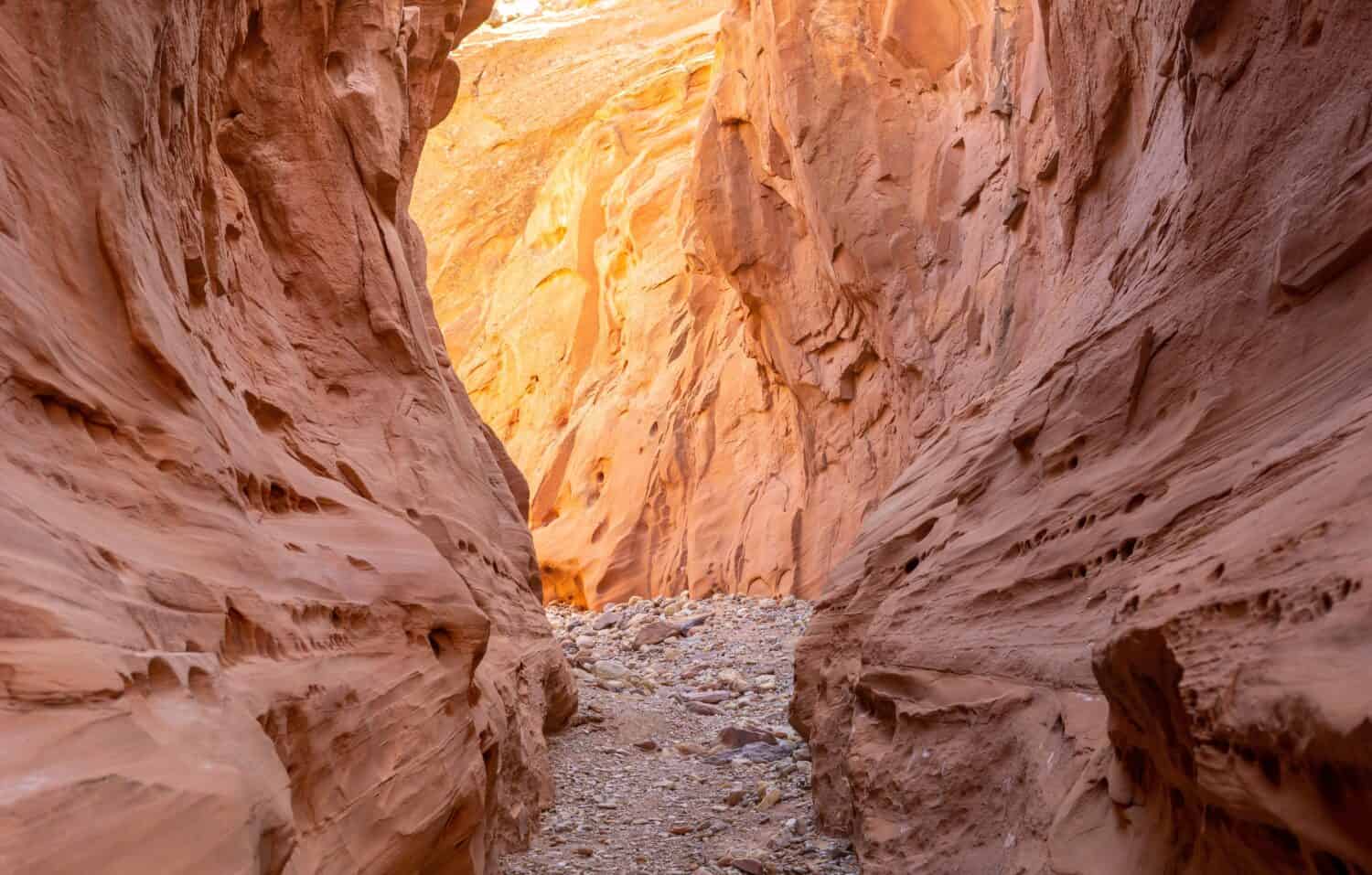
Turn a day of canyoneering into an overnight trip, just make sure you have the right camping permits.
©Anaredif/Shutterstock.com
Tall, red sandstone cliffs surround the famous Little Death Hollow. This remote hike can be a one-day adventure, or you can turn it into an overnight trip! Some of the frequently explored canyons in this area include Upper and Lower Calf Creek Falls, and Upper and Lower Escalante.
15. Jenny’s Canyon
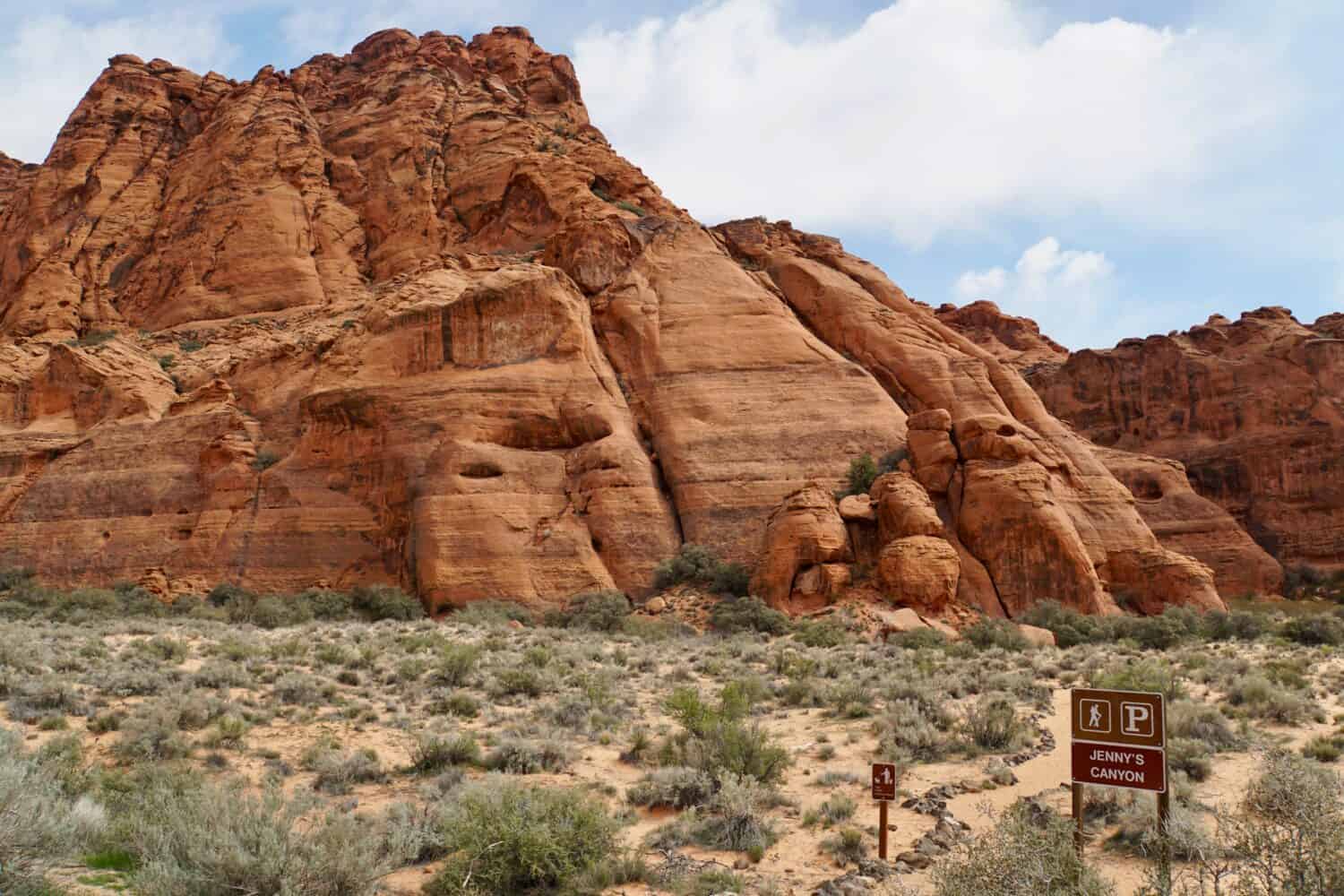
Always look for the trailhead sign and stay on mapped trails at all times.
©jenpeng/Shutterstock.com
Looking for an easy 20-minute hike? Then head out to Jenny’s Canyon! Spring is a great time to explore and see colorful wildflowers blanket the canyon. As with most canyons, start at the signed trailhead, and stay on mapped trails at all times. Pay close attention to carved pockets higher in the slot, as you may spot signs of nesting peregrine falcons.
16. Little Wild Horse
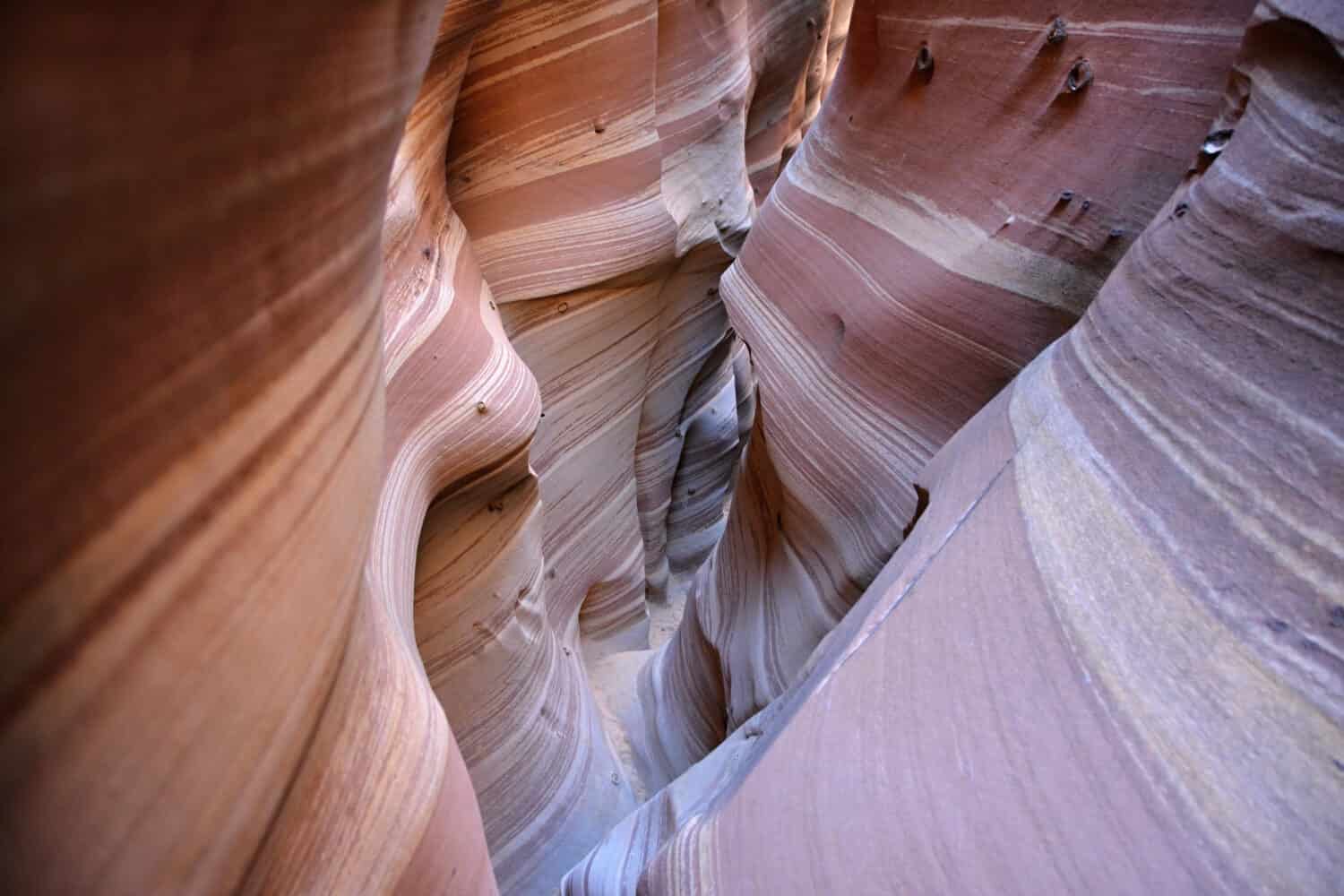
Bring your camera to capture captivating rock formations and swirling narrows.
©Caroline Lib33/Shutterstock.com
Plan a trip to see a classic slot canyon hike in the southern San Rafael area. Only 5 miles west of the Goblin Valley State Park Visitor Center, you’ll find Little Wild Horse Canyon. This is a good spot for intermediate canyoneers to experience. The canyon offers non-technical canyoneering and is suitable for most people in decent shape. The 8-mile course is filled with captivating rock formations and swirling narrows.
17. Ding and Dang
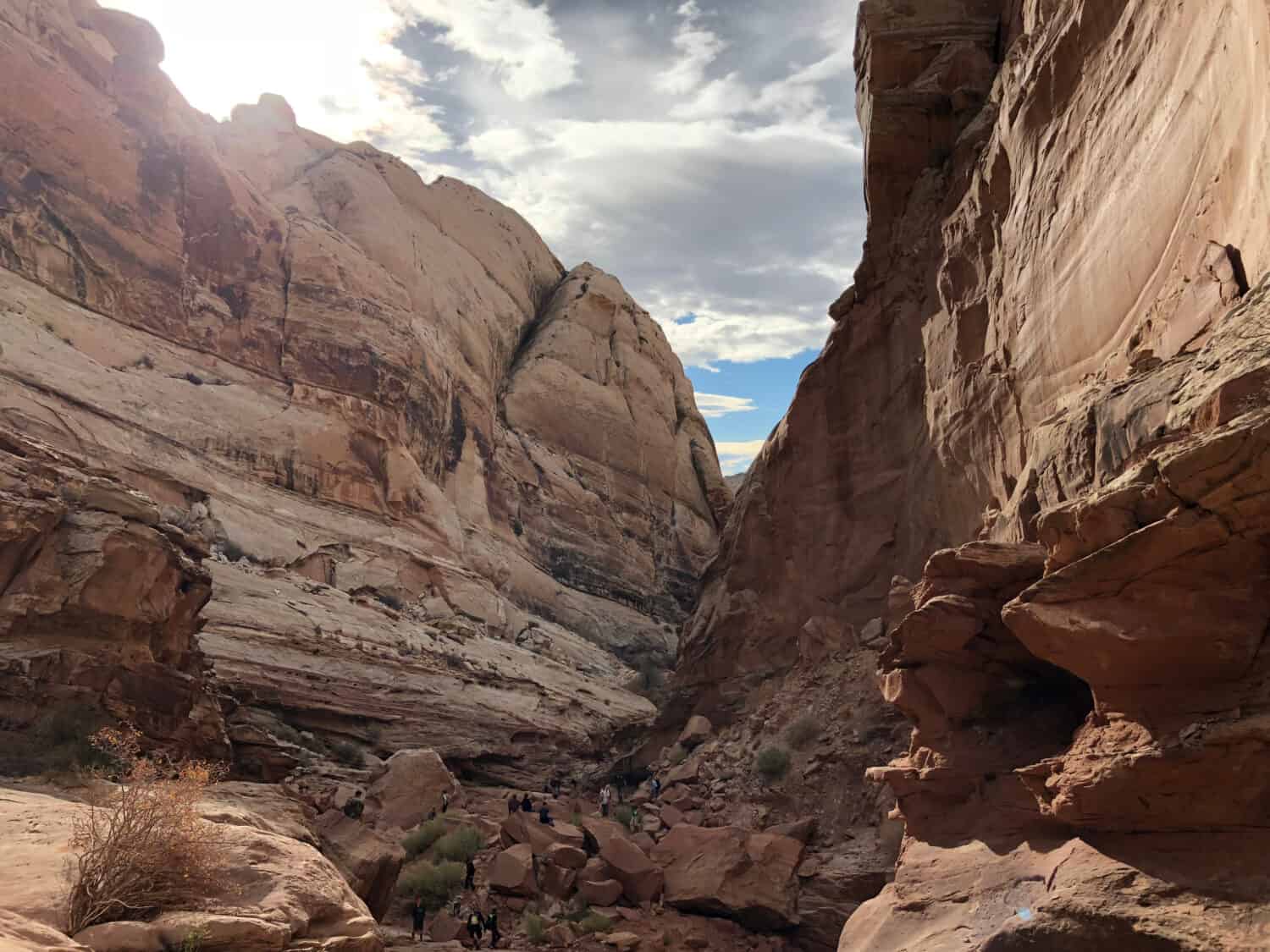
It’s a good idea to bring your wading shoes in case you encounter pools of shallow water.
©Dwightwagner/Shutterstock.com
Right by Little Wild Horse, you’ll find a couple of more challenging canyons; Ding and Dang. To reach these canyons, go about 1.3 miles past the Little Wild Horse trailhead, where you’ll find a small parking lot. Bring your wading shoes since some parts of the narrows may have water. For more thorough explorations, consider hiring a guide.
18. Spring Creek Canyon
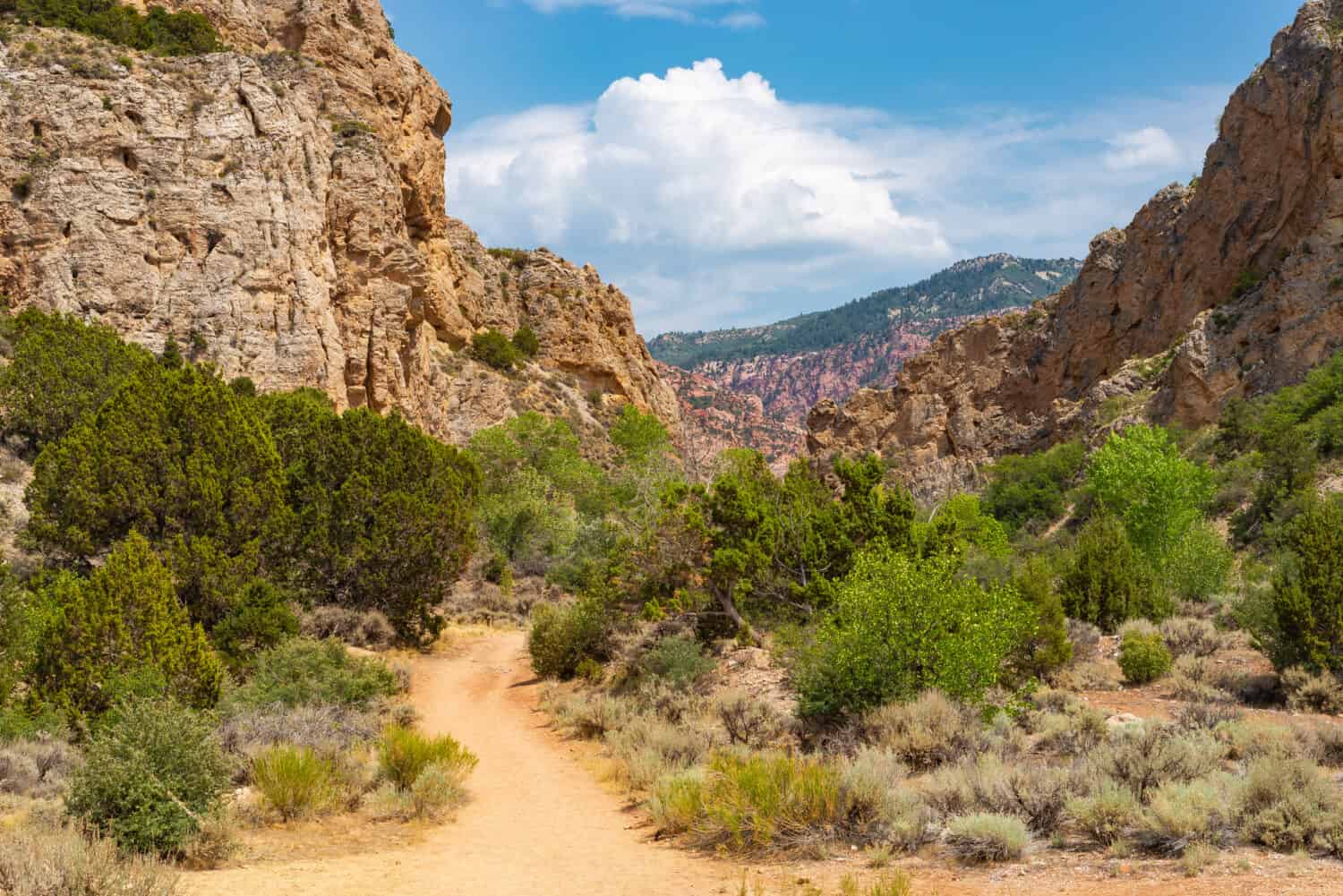
While some hikes to slot canyon locations are easy, others offer a more challenging and steep terrain.
©Eddie J. Rodriquez/Shutterstock.com
Visit a wilderness study area that’s also a slot canyon; Spring Creek Canyon. Here you’ll enjoy a moderately difficult hike that’s only about 5.5 miles round trip. While you could explore further into the canyons, the first 2.75 miles are the easiest to access. After this point, the terrain becomes steeper, and the forks become overgrown. Because Spring Creek Canyon is a Wilderness Study Area no vehicles are allowed. To reach the canyon, follow the route that leads southeast toward the cliffs. In a little less than a mile you’ll find a designated parking area and trailhead.
19. Willis Creek Narrows

Slot canyons are famous for providing some of the most awe-inspiring colors and textures.
©Sonicpuss/Shutterstock.com
Embark on a 3-hour adventure at Willis Creek Slot Canyon. The narrow section towers 100 feet above your head and extends for about 1.3 miles, it’s an area full of awe-inspiring textures and colors. As the narrows lessen, the trail continues along the creek for an additional 2.4 miles. This is a great spot for beginners, everything is highly accessible. After parking your car, your adventure begins.
20. Wireless Trailhead
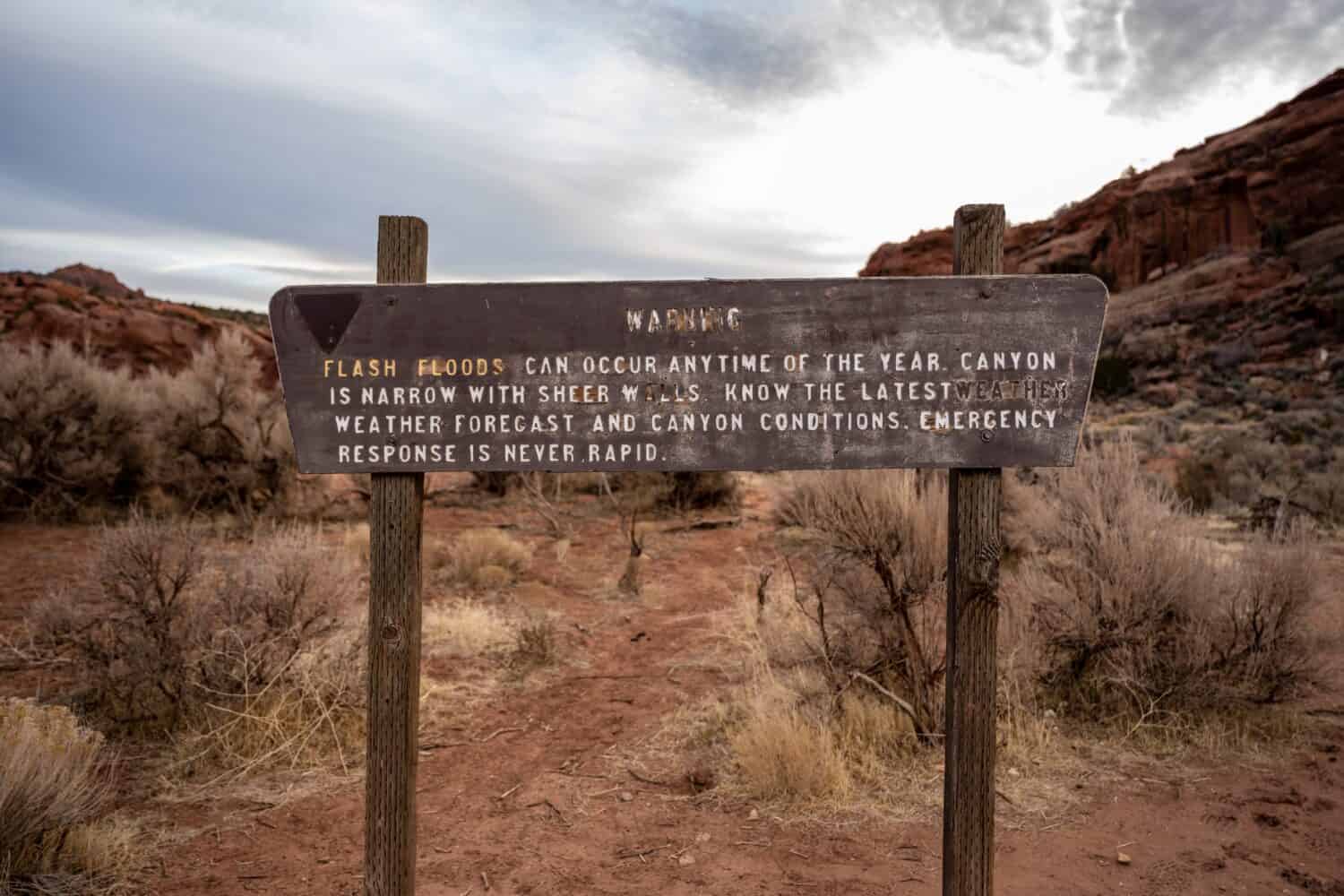
Flash flood warning signs, common sights around slot canyons, help warn hikers of potential danger.
©Kelly vanDellen/Shutterstock.com
Explore Wire Pass Trailhead in less than 3 hours. This slot canyon is easy to explore and best to visit April through early June, or September through October. Wire Pass, carved through The Cockscomb by Coyote Wash, serves as the primary entry point into Buckskin Gulch. The easy hike takes you through Wire Pass and into the famous Buckskin Gulch. To avoid a flash flood, never venture out if there’s even a slight chance of rain.
What Spot Is the Easiest to Get To?
Which slot canyon from this list is the easiest to access? Wire Pass is one of the easiest slot canyons in all of Utah. It’s a smart choice when you want to experience the beauty of slot canyons without needing technical expertise. The easy-to-access side canyon intersects with Bucksin Gulch where you can find petroglyphs on the canyon walls.
Wildlife You Might Encounter
As you get ready to head out for a slot canyon adventure, what type of animals should you expect to see? Utah is home to all sorts of animals, and many of them are happy to call the canyonlands their home.
Here are a few of the animals you might see while hiking in and around slot canyons:
- Pronghorn Antelope
- Rock Squirrel
- Hares
- Mule Deer
- Foxes
- Bats
- Peregrine Falcon
- California Condor
- Bighorn Sheep
- Ringtail Cat
- Mountain Lion (Cougar, Puma, Panther)
- Porcupine
- Skunk
- Raccoon
- Beaver
- Bobcat
- Coyote
- Gray Fox
Many Canyonlands desert animals are nocturnal, staying active at night to avoid daytime heat and predators. These include kangaroo rats, woodrats, small rodents, skunks, ringtails, foxes, bobcats, mountain lions, bats, and owls. Some of the animals that are more active during the day include pronghorn antelopes, chipmunks, lizards, snakes, hawks, and eagles.
What Creates Slot Canyons?
Slot canyons have steep, high walls, often composed of soft rock like basalt or sandstone. Primarily shaped by forces of erosion, including water and wind, slot canyons can be found in dry and semi-dry regions worldwide. Utah has the largest concentration of these geological formations in the world, with more than 1,000 slot canyons. The state’s soft sandstone formations provide perfect conditions for their development.
How does wind or water create slot canyons in Utah? By being relentless. Over millions of years, rushing water carves out the narrow channels and smooth, curving canyon walls. Oftentimes the water comes from flash floods. Wind is another key player in eroding canyon walls and deepening channels. Wind-blown sand and abrasive particles gradually wear away the rock, creating intricate designs in the process. The eroded sandstone walls are both soft to touch and mesmerizing to look at.
Slot Canyon Safety Tips
Slot canyons are susceptible to flash floods during rainstorms. All it takes is 1/4 inch of rain for slot canyons to transform into a treacherous water-course. That’s why you should always check the weather before exploring. Get the local forecast by going to NOAA.gov. They’ve got all the weather info you need, including satellite water vapor images, which tell you if there’s a lot of moisture in the sky.
Even after checking the weather forecast, keep an eye on the sky for any dark clouds, especially in July and August. These summer months are notorious for rainstorms. If you hear thunder, go to higher ground quickly.
Finally, make your adventure even safer by choosing a slot canyon with exits every 15 minutes along the route. This way, if anything goes wrong, you can get out quickly.
Hiking vs. Canyoneering: Which Choice Is Right for You?
Should you hike or canyoneer? The answer depends on your experience and the type of adventure you want. Hiking is ideal for those seeking a relaxing adventure, while canyoneering involves technical descents and occasional water pools. Consider hiring experienced local guides for canyoneering trips, especially if you are new to the activity. And plan your trip for the right time of year. April and June are prime months for canyoneering.
Whether you’re hiking or canyoneering, prepare to take frequent rest and hydration breaks. Finally, bring the right supplies such as water, maps, and a first-aid kit. Bringing a friend or group will make it easier to navigate changing conditions.
Canyoneering Techniques
Here are a few canyoneering techniques and maneuvers that can help you through a slot canyon:
Bridging: Traverse wide slots by bracing hands and feet on opposite walls.
Rappelling: Descend steep sections of canyons using a rope and appropriate rappelling device.
Stemming: For 3 to 4-foot wide canyons, use one hand and one foot on each side.
Pot Holing: Potholing refers to navigating through deep pools or potholes in a canyon
Chimneying: In narrower slots, use your back against one wall and your feet or knees against the opposite.
Handlining: A technique for safely moving down short, steep drops or dry waterfalls using a rope for balance and control.
Anchoring: Make steep or exposed terrain passable with safe anchors using slings or webbing.
Belaying: The belay device protects climbers going up or down. The belayer controls the rope for safety.
Always avoid overly technical maneuvers above risky landings.
Summary Table: Slot Canyons in Utah
| 20 Locations | Utah Slot Canyons |
|---|---|
| 1 | Antelope Canyon |
| 2 | Moonshine Wash |
| 3 | Red Hollow Slot Canyon |
| 4 | Leprechaun Canyon |
| 5 | Buckskin Gulch |
| 6 | Kanarra Falls |
| 7 | Keyhole Canyon |
| 8 | Wire Pass Slot Canyon |
| 9 | Paria Canyon |
| 10 | The Narrows |
| 11 | The Dry Fork Narrows |
| 12 | The Subway |
| 13 | Zebra Canyon |
| 14 | The Joint Trail |
| 15 | Little Death Hollow |
| 16 | Jenny’s Canyon |
| 17 | Little Wild Horse Canyon |
| 18 | Ding and Dang |
| 19 | Spring Creek Canyon |
| 20 | Willis Creek Narrows |
The photo featured at the top of this post is © iStock.com/Left_Coast_Photographer
Thank you for reading! Have some feedback for us? Contact the AZ Animals editorial team.






